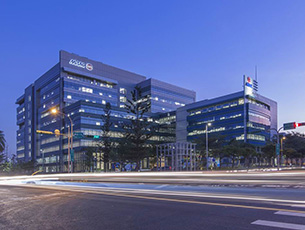Supply Chain Sustainability Management
|
To ensure social responsibility and compliance within our supply chain, we require all suppliers to sign a "Supplier Corporate Social Responsibility Statement". We also have a "Supplier Code of Conduct" to clearly outline their commitments to human rights, the environment, occupational safety, and ethical risks. This measure aims to strengthen the resilience of our supply chain and encourages suppliers to actively participate in and improve relevant areas. In addition to quality operations audits, we conduct Responsible Business Alliance (RBA) audits to ensure that suppliers' operations comply with relevant standards. These audits cover various aspects such as labor ethics and environmental health and safety to comprehensively assess suppliers' social responsibility status. If deficiencies are found during the audit process, we assist suppliers in developing improvement measures and require them to complete the improvements within the specified timeframe. |
 |
Necessary certifications must be obtained for critical suppliers:
- Material suppliers related to the manufacturing process: Must pass the ISO9001 quality management system certification
- Contractors of plant affairs and related operations: Must obtain the ISO45001 occupational health and safety management system certification
- Local suppliers: Must obtain valid factory registration certificate issued by local government in accordance with the business category as well as ISO14001 environmental certification
The Company also makes use of the supplier management platform e-SCM to ask the suppliers to provide test reports on the environmental specifications of products such as HSF (Hazardous Substance Free), so as to ensure that the products meet the RoHS requirements. With regard to the conflict mineral issues, promptly requesting the suppliers to ensure the compliance of the supporting materials offered thereby for proper source management in the supply chain in response to the RBA’s Responsible Minerals Initiative (RMI) while meeting the requirements of the customers.
|
Conflict Minerals Management |
|---|
Based on our risk management identification results, the MiTAC Group categorizes materials involving conflict minerals as critical materials. The “Conflict Mineral Procurement Policy” is part of the supplier green product management of the Company. We achieve “management at source” by implementing investigations of smelters, and investigate all raw materials annually purchased for use in the processes based on the Conflict Minerals Reporting Template (CMRT)/Extended Minerals Reporting Template (EMRT) questionnaires for the non-use of conflict minerals, so as to determine whether the raw materials procured and used in our processes contain conflict minerals and their sources. In 2024, the response rate for CMRT/EMRT surveys was 100%, ensuring that both MiTAC and its suppliers are committed to complying with relevant regulations. Should you have any inquiries regarding conflict minerals, please contact us at CMRT@mic.com.tw. We will conduct due diligence based on the information provided.
 |
In 2024, a total of 252 supplier investigations were conducted, resulting in the identification of 358 mineral smelters. This effort aims to ensure that both MiTAC and its group of suppliers are committed to complying with relevant regulations.
|
|
|
Supply Chain Risk Management |
|---|
The current global economic and supply chain environment faces unprecedented uncertainty, making supply chain risk management a critical component of corporate sustainable development. We closely monitor market trends and industry dynamics, and strive to build a stable and resilient supply chain system to address various potential external risks and challenges, such as supply disruptions, price volatility, transportation issues, climate change factors, and natural disasters. By diversifying supplier sources, strengthening supplier relationship management, and establishing contingency plans, we ensure the stability and sustainability of our supply chain.

|
Local Procurement |
|---|
With the R&D and design processes in Taiwan and the USA, the module and semi-finished product manufacture in the production sites in China, and the FCL and assembly processes in the USA, we have formed a global division of labor manufacturing model. To build close relationship with local partners, the parts, components and systems that are of a low level or need a long period of shipment are produced in Taiwan and China, while the major components with high unit price are procured and used for assembly at the production bases in close proximity to the customers.

|
Restrictions on the Use of Hazardous Substances |
|---|
|
MiTAC Product Environmental Management and Regulations |
To achieve the goal of producing environmentally friendly products, MiTAC ensures that all components and materials selected comply with international regulations, such as the EU RoHS Recast, WEEE Recast, REACH, POPs, Section 6(h) of TSCA, China VOC directives, and China’s Administrative Measures for the Control of Pollution from Electronic Information Products. The supply chain is strictly required to comply with MiTAC’s environmental management specifications (GP-1-00001). Through green supply chain management and hazardous substances management, MiTAC provides products with low toxicity and low pollution, reducing harm to the environment and human health.
MiTAC Annual Hazardous Substance Management Process

|
Establishment of Green Product Management System |
MiTAC has developed the Green Product Management System (eGP System) and the Supply Chain Management System (eSCM System). By leveraging cross-platform collaboration, suppliers can use the internet to report the presence of hazardous substances in components through the eGP System, upload third-party testing reports, and provide Full Material Declaration (FMD) reports, thereby promptly responding to customer-related green management information.
The management of the eGP and eSCM platform systems ensures that products meet the latest environmental regulations (regional and customer-specific restrictions), enhancing the rigor and efficiency of MiTAC's green product management system. This process helps to identify qualified and capable suppliers, providing electronic and mechanical components that comply with environmental regulations, thereby boosting green competitiveness and increasing customer trust and satisfaction.


Suply Chain Management System- eSCM System |

Green Product Management System - eGP System |
|
Incoming Material Inspection and Sampling Testing |
- Providing low-toxicity, low-pollution green products: This is achieved through upstream supply chain management by strengthening the design and manufacturing management of suppliers.
- Utilizing the eSCM / eGP systems to communicate with suppliers and manage the greens standard of components: This ensures compliance with international and customer environmental standards.
- Establishing preventive strategies: This involves setting up a hazardous substance analysis laboratory to conduct sampling tests on incoming materials, effectively preventing non-compliant environmental products from entering or leaving the supply chain.


















